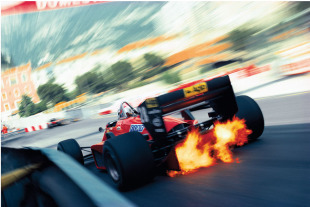- Interview with Rainer Schlegelmilch
The art of F1 photography

- Drivers:
- Stefan Johansson
- |
- John Surtees
Rainer Schlegelmilch has been a professional motorsport photographer for over 40 years. Ever since his first race in the early 1960s, Schlegelmilch has made a career that combines his passion for both photography and motor racing to build a reputation as one of the most successful photographers in his field.
After studying Art Photography at the Bavarian State School of Photography, Schlegelmilch found inspiration for his final exams purely by chance after being invited to watch a race at the Nurburgring in 1962.
"I loved it," said Schlegelmilch as he remembers how it all began. "I loved to go there, I enjoyed the people and I enjoyed doing car photography."
From then on, Schlegelmilch set about trying to create the best images in motor racing, covering everything from Formula One to Le Mans, and still works as a successful freelance photographer today.
"It was funny, when I started to do the racing photography, I was there just to do my school exams and I wanted to do a series of maybe ten portraits. And I was focused on faces, on portraits of concentration."
Some of the portraits Schlegelmilch is referring to are now part of an exhibition at Proud Galleries in Camden entitled The Golden Age of Formula One, a name taken from Schlegelmilch's new book set to be released October 30.
"The golden age was my first decade of photography. Everything that you do when you're young you think it's the greatest", said Schlegelmilch, defining what this title meant to him and his work.
Schlegelmilch watched motor racing evolve during his extensive career, and remembers how different Formula One used to be when his career began in the early 1960s.
"The people there were friendlier towards each other. There was a lot more camaraderie between drivers, photographers, journalists, team bosses. It was a great family. But now it's too big.
"Everywhere [in Formula One] the money difference between the rich and the poor is too big a contrast. It's a lot more difficult. Therefore I call [the 1960s] the greatest time, when there were not so many people in the teams, only a few mechanics, bosses and drivers."
To be more specific, Schlegelmilch's 'Golden Age' was from 1962 to 1969, the years when his photographs were in black and white. From 1970 onwards, the demand for colour images became greater, meaning Schlegelmilch had to make the switch to suit his employers' demands.
Even though the German photographer was now conforming to what was wanted, rather than his own preferences, he still believed the images he was taking were unique compared to everyone else at that time.
"I studied photography, but most of the people [at the races] were reporters. They came from magazines or daily papers, they were just snappers. I had done two years in an art school to study photography. So you go with a totally different feeling.
"I didn't want to do documentation for a magazine, I did it for myself. I just wanted to do good photography."
Fortunately for Schlegelmilch, his reputation grew in strength and has now retaken control of his career, making every decision about the production of his photographs.
"I'm totally freelance, and I have no people telling me that they need certain pictures. I can work freely, which is the best motivation for a photographer. I do good photos of whatever I like. That's my engine, that's what's pushing me."
The Proud Galleries exhibition is dominated by the black and white photographs that Schlegemilch has a great affection for, however when considering his best photograph from the series, the image he chose was in colour.

"This is one of my best shots ever because it had great zoom, at the exact right moment for the movement of the zoom," said Schlegelmilch. "And because it was a turbo, and they push the throttle backwards and forwards, it makes a huge flame come out. It was an exact moment and is one of my best shots ever."
Regardless of the subject matter, Schlegelmilch is confident that the exhibition will appeal to everyone, believing the images alone have the ability to translate the same sentiment to both F1 fans and newcomers to the sport.
"Everyone who goes to an exhibition like that won't be an expert on Formula One, but they will see faces, they will hear names and they will learn.
"They know little bits, such as the engine is very strong in a Formula One car, they have fire proof suits and that these are really extremely interesting people who work there, especially the drivers.
"We know that these guys are very important and they are specialists in their job and they are great sportsmen."
All the images from the exhibition are on sale, with a starting price of £99 unframed. The exhibition is free entry and is running until October 24.

